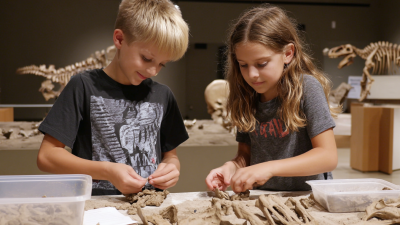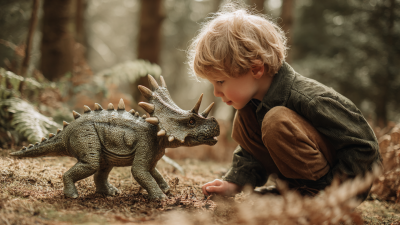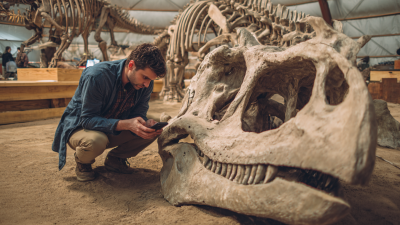How to Uncover Ancient Life with Amber Excavation Kits and Insect Preservation
Table of Contents
- Choosing the Right Amber Excavation Kit for Your Needs
- Essential Tools and Materials for Insect Preservation Success
- Step-by-Step Guide to Excavating Amber Like a Pro
- Techniques for Safely Preserving Insects in Amber
- Documenting Your Finds: Creating a Catalog of Excavated Life
- Understanding the Science Behind Amber and Fossil Insects
- FAQS
- Conclusion
- Related Posts
In recent years, the fascination with paleontology and the exploration of ancient life has spurred a growing market for innovative archaeological toys, particularly the amber excavation kit with insects. According to industry reports, the global market for educational toys is projected to reach $93 billion by 2025, with a significant segment dedicated to science-based kits that enhance learning through hands-on experience. Jinhua City Dukoo Toys Co., Ltd., established in 2009, has been at the forefront of this trend, specializing in customizing archaeological products that cater to a diverse customer base worldwide. With our manufacturing space expanding from 400 to 8000 square meters over nearly 13 years, we are committed to providing high-quality excavation kits that not only empower young explorers to uncover ancient life but also instill a deeper appreciation for the sciences through engaging and educational play.

Choosing the Right Amber Excavation Kit for Your Needs
When it comes to selecting the right amber excavation kit, understanding the features that suit your needs is crucial. Reports from the Paleontological Society indicate that amber is predominantly found in regions with historical tropical or subtropical climates, making it essential for aspirant paleontologists to choose kits designed for those specific environments. A quality amber excavation kit should include specialized tools such as scalpels, tweezers, and magnifying lenses, which aid in careful handling and preservation of any embedded specimens.

Tips: When evaluating an amber excavation kit, consider the size of the amber samples you plan to collect. Kits designed for larger specimens often include heavier-duty tools, while those intended for finer work may prioritize precision instruments. Reading reviews and testimonials from other users can provide insights into the kit's effectiveness and practicality.
Moreover, selecting kits from reputable suppliers who guarantee the provenance of their amber can enhance your excavation experience. According to research from the American Museum of Natural History, amber preserved from the Cretaceous period can contain a diverse range of insects and plant materials, offering a glimpse into prehistoric ecosystems. Therefore, detailed product descriptions and ingredient sourcing are vital in ensuring the quality and authenticity of your excavation kit.
Essential Tools and Materials for Insect Preservation Success
When embarking on the exciting journey of insect preservation, having the right tools and materials is crucial for success. A well-equipped amber excavation kit typically includes essential items such as tweezers, scalpel blades, resin containers, and magnifying glasses. These tools not only aid in the careful extraction of insects but also ensure that they remain intact for study and display. Additionally, a quality microscope can enhance the experience by allowing a closer examination of intricate details, revealing the fascinating features of ancient life.
Tips: Always handle insects with care using tweezers to avoid damage. Additionally, consider using clear resin for encasing the specimens, as this helps in maintaining their condition over time. If you're aiming for a professional finish, investing in UV-resistant amber resin can prevent yellowing, preserving the beauty of your findings.
When selecting materials, prioritize high-quality, non-toxic substances for preserving your specimens. Natural resin is recommended as it captures the essence of ancient environments. Lastly, make sure your workspace is clean and organized to reduce the risk of contamination during the preservation process, ensuring that your insects are presented in the best possible condition.
Step-by-Step Guide to Excavating Amber Like a Pro
Excavating amber is an intriguing journey into the past, where you can uncover ancient life trapped in this prehistoric resin. To begin, gather the right tools: an amber excavation kit typically includes safety goggles, a digging tool, and a brush. Ensure you are equipped with a good light source, as the translucence of amber can be best appreciated under proper lighting. Start by identifying an area that is likely to yield amber deposits; research geological formations that are known for amber finds.
Once you've chosen your spot, gently dig around the surface layer, being careful not to apply too much pressure to avoid damaging potential specimens. As you uncover layers, use your brush to carefully remove dirt, revealing the amber and any inclusions, such as insects, trapped within. When you spot a piece, take your time to excavate around it so it can be safely extracted without breaking. After retrieving your amber, clean it thoroughly with mild soap and water to reveal its natural beauty, allowing you to appreciate the captivating snapshot of ancient life it houses.
Techniques for Safely Preserving Insects in Amber
Insect preservation using amber excavation kits is a fascinating niche that combines both science and art. The process starts with careful selection of amber, the fossilized tree resin that has captured insects over millions of years. Choosing pieces with visible inclusions notably enhances the chances of discovering preserved specimens. It's essential to handle the amber gently to avoid damaging both the resin and the insects trapped within.

Once the appropriate amber is selected, techniques for safely extracting and preserving insects are paramount. This requires specialized tools such as scalpels and soft brushes to meticulously free the specimens without causing harm. After extraction, preservation techniques enhance visibility and durability; methods include using silica gel for drying and clear mounting media for optimal display. By applying these careful techniques, enthusiasts can not only recover ancient life forms but also contribute to our understanding of ecosystems long gone. Each extraction reveals a piece of history, making the process both rewarding and educational.
Documenting Your Finds: Creating a Catalog of Excavated Life
When embarking on the exciting journey of amber excavation, documenting your finds is crucial for both understanding and preservation. Creating a catalog not only helps in organizing your discoveries but also enhances the overall experience of excavation. Begin by setting up a systematic approach: date each discovery, note the specific location of the find, and carefully describe the characteristics of the amber and any inclusions such as insects or plant material. This level of detail will provide invaluable context for your specimens and facilitate future research or sharing with the community.
In addition to written documentation, consider incorporating photography into your cataloging process. High-quality images can visually capture the unique features of your finds, making it easier to track changes over time or compare similar specimens. Alongside the images, include notes on the conditions of the excavation site and any relevant environmental factors. By meticulously documenting your finds, you create a comprehensive archive that not only serves your personal interests but contributes to the broader understanding of ancient ecosystems preserved in amber.
How to Uncover Ancient Life with Amber Excavation Kits and Insect Preservation - Documenting Your Finds: Creating a Catalog of Excavated Life
| Find ID | Type of Insect | Amber Age (Million years) | Location Found | Notes |
|---|---|---|---|---|
| 001 | Bee | 100 | Borneo | Well-preserved with wings visible |
| 002 | Midge | 90 | Myanmar | Small size, details of legs clear |
| 003 | Beetle | 85 | Dominican Republic | Dorsal view detailed, possible new species |
| 004 | Fly | 75 | Canada | Impressive color patterns retained |
| 005 | Cockroach | 100 | Southeast Asia | Large specimen, good preservation of details |
Understanding the Science Behind Amber and Fossil Insects
Amber, often referred to as "nature's time capsule", provides a unique window into ancient ecosystems. Recent discoveries reveal previously unknown species of parasitic fungi, dating back 99 million years, which highlight the intricate relationships between plants and insects that existed alongside dinosaurs. This remarkable preservation allows paleontologists to study the evolution of parasitic relationships, shedding light on how these organisms coexisted and influenced one another in prehistoric environments.
Furthermore, amber excavations have unveiled stunning insect fossils, offering insights into the colors and forms of ancient life. For instance, researchers recently gathered 35 pieces of amber from northern Myanmar, containing exquisitely preserved specimens that illuminate the biodiversity of ancient rainforests. The discovery of a bioluminescent beetle, trapped in amber for nearly 100 million years, suggests that such fascinating adaptations were already evolving during the age of dinosaurs. Each piece of amber serves as a testament to Earth's rich biological history, encouraging scientists to explore the tales trapped within these primal artifacts.
FAQS
: Consider the features that suit your needs, such as the size of amber samples you plan to collect and whether you need heavy-duty tools or precision instruments.
A quality kit should include tools like scalpels, tweezers, magnifying lenses, resin containers, and, optionally, a microscope for closer examination.
Reputable suppliers guarantee the provenance of their amber, which enhances the authenticity and quality of your excavation experience.
Use tweezers to handle insects carefully, consider encasing them in clear, UV-resistant amber resin, and ensure your workspace is clean to avoid contamination.
Use specialized tools such as scalpels and soft brushes to gently free the specimens without causing damage.
High-quality, non-toxic resin helps maintain the condition of the specimens over time and prevents yellowing, preserving their beauty.
Amber is predominantly found in regions with historical tropical or subtropical climates, making it crucial to select excavation kits designed for these environments.
By carefully extracting and preserving insects, you can uncover pieces of history that provide insights into prehistoric life and ecosystems.
Silica gel is used for drying the specimens to enhance their visibility and durability after extraction.
Reviews and testimonials from other users can provide insights into the kit's effectiveness and practical use in real-life scenarios.
Conclusion
The article titled "How to Uncover Ancient Life with Amber Excavation Kits and Insect Preservation" offers a comprehensive guide for enthusiasts interested in the captivating world of amber and its preserved insects. It begins by assisting readers in choosing the right amber excavation kit with insects tailored to their specific needs. Essential tools and materials for successful insect preservation are highlighted, along with a detailed step-by-step approach to excavating amber like an expert.
Furthermore, the article delves into techniques for safely preserving insects found within amber, emphasizing the importance of documenting these finds to create a valuable catalog of excavated life. By understanding the science behind amber and fossil insects, readers can appreciate the significance of their discoveries. Companies like Jinhua City Dukoo Toys Co., Ltd., which specialize in innovative archaeological toys since 2009, play a vital role in providing the necessary kits and tools, enabling enthusiasts worldwide to explore and connect with the ancient life encapsulated in amber.
Related Posts
-

Ultimate Guide to Unleashing the Secrets of Your Crystal Mining Kit
-

How to Create Exciting Learning Experiences with a Dinosaur Fossil Dig Kit
-

Creative Solutions for Enhancing Learning with Prehistoric Fossil Dig Toys
-

The Future of Interactive Dinosaur Bone Dig Experiences
-

How to Unlock the Secrets of Fossil Discovery Toy for Young Explorers
-

7 Creative Tips for Maximizing Fun with Parent-child Educational Dig Toys
Blog Tags:

